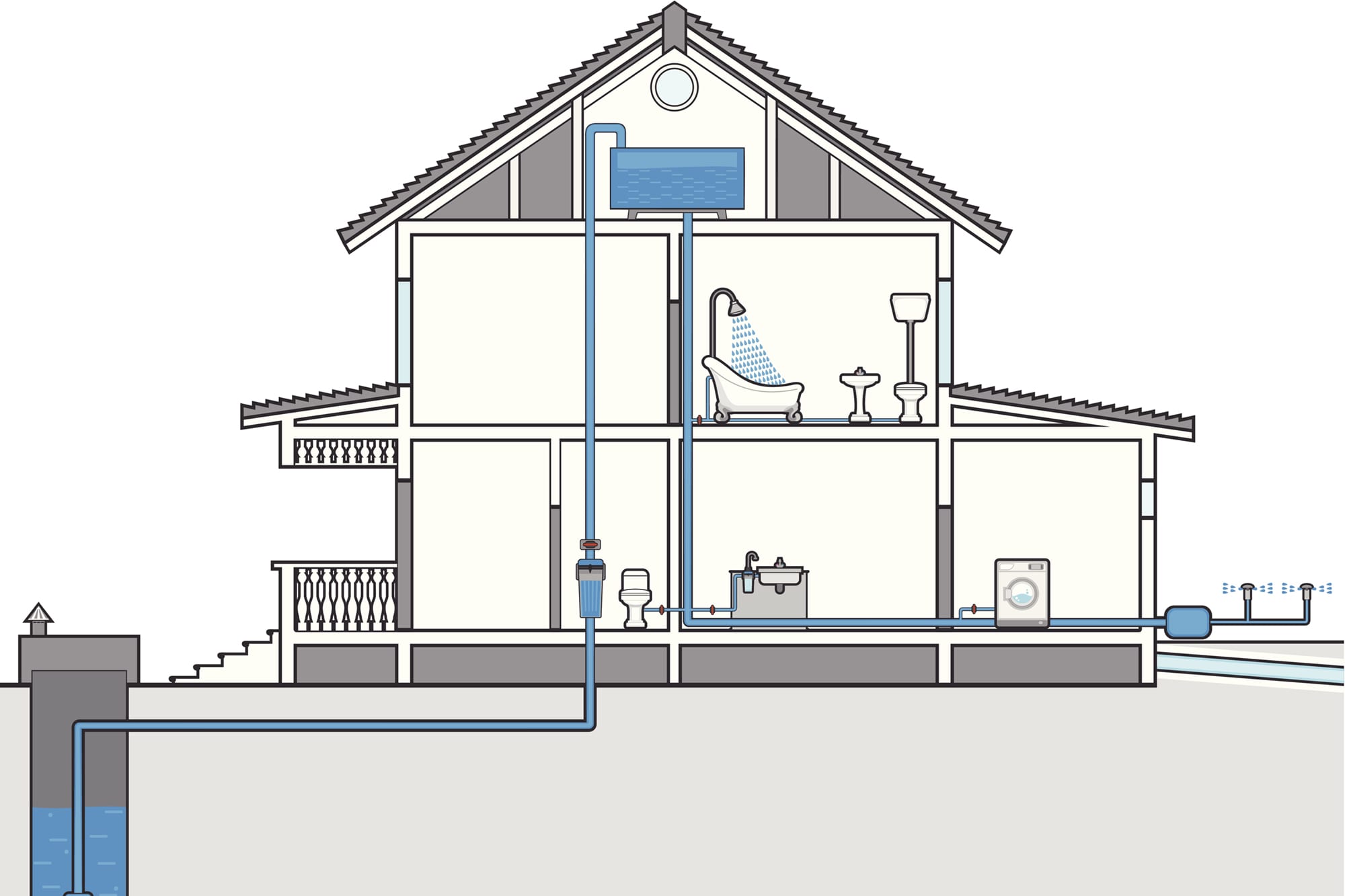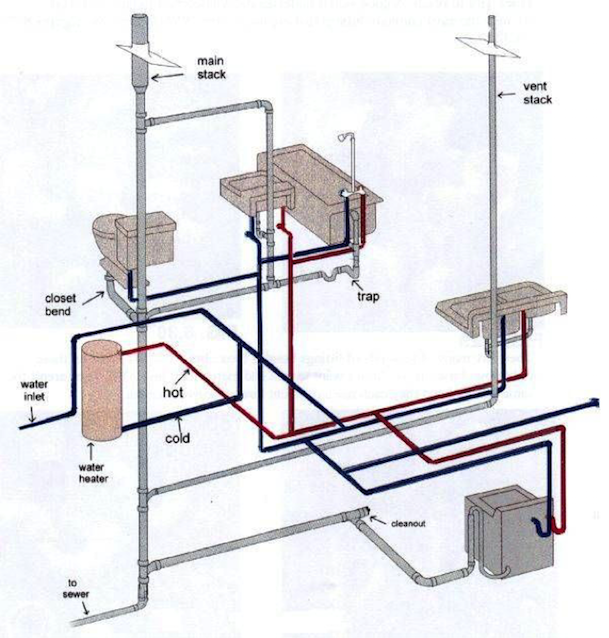Understanding Your Property's Plumbing System Anatomy
Understanding Your Property's Plumbing System Anatomy
Blog Article
We have uncovered this post about Anatomy of a House: Understanding the Components down the page on the net and think it made good sense to discuss it with you on this site.

Understanding just how your home's pipes system works is vital for every home owner. From providing tidy water for drinking, food preparation, and bathing to safely removing wastewater, a well-kept pipes system is critical for your family members's health and convenience. In this extensive guide, we'll explore the intricate network that makes up your home's plumbing and offer tips on maintenance, upgrades, and taking care of usual concerns.
Intro
Your home's pipes system is greater than just a network of pipes; it's an intricate system that ensures you have accessibility to tidy water and reliable wastewater elimination. Recognizing its parts and how they interact can aid you prevent costly repairs and make sure everything runs efficiently.
Basic Parts of a Pipes System
Pipes and Tubes
At the heart of your pipes system are the pipes and tubes that lug water throughout your home. These can be made from various products such as copper, PVC, or PEX, each with its advantages in regards to longevity and cost-effectiveness.
Fixtures: Sinks, Toilets, Showers, and so on.
Components like sinks, toilets, showers, and bath tubs are where water is utilized in your house. Recognizing how these fixtures connect to the pipes system aids in detecting troubles and planning upgrades.
Shutoffs and Shut-off Factors
Shutoffs control the flow of water in your pipes system. Shut-off valves are critical throughout emergencies or when you require to make repair work, allowing you to separate parts of the system without disrupting water circulation to the entire house.
Water Supply System
Main Water Line
The major water line links your home to the metropolitan supply of water or a private well. It's where water enters your home and is distributed to numerous fixtures.
Water Meter and Stress Regulator
The water meter procedures your water usage, while a stress regulatory authority makes sure that water streams at a safe stress throughout your home's plumbing system, protecting against damage to pipes and components.
Cold Water vs. Hot Water Lines
Recognizing the difference in between cold water lines, which supply water directly from the major, and warm water lines, which bring warmed water from the water heater, aids in troubleshooting and planning for upgrades.
Water drainage System
Drain Pipeline and Traps
Drain pipelines carry wastewater away from sinks, showers, and commodes to the sewage system or sewage-disposal tank. Catches avoid sewer gases from entering your home and likewise trap debris that could trigger obstructions.
Ventilation Pipelines
Air flow pipes permit air into the water drainage system, stopping suction that could slow water drainage and create traps to vacant. Proper ventilation is necessary for keeping the integrity of your pipes system.
Significance of Appropriate Water Drainage
Making sure correct drainage avoids back-ups and water damage. On a regular basis cleaning up drains pipes and keeping catches can prevent expensive repairs and expand the life of your plumbing system.
Water Heating System
Sorts Of Water Heaters
Hot water heater can be tankless or traditional tank-style. Tankless heating systems warmth water on demand, while tanks save warmed water for instant usage.
Just How Water Heaters Connect to the Plumbing System
Comprehending just how hot water heater connect to both the cold water supply and hot water circulation lines assists in diagnosing issues like insufficient warm water or leaks.
Upkeep Tips for Water Heaters
Regularly flushing your hot water heater to get rid of debris, checking the temperature level setups, and examining for leaks can prolong its lifespan and enhance power performance.
Usual Pipes Concerns
Leakages and Their Reasons
Leakages can happen because of maturing pipes, loosened installations, or high water pressure. Attending to leaks without delay stops water damage and mold and mildew growth.
Blockages and Obstructions
Clogs in drains pipes and commodes are usually triggered by purging non-flushable products or an accumulation of grease and hair. Using drain screens and being mindful of what goes down your drains pipes can stop blockages.
Indicators of Plumbing Problems to Expect
Low water pressure, slow drains, foul odors, or unusually high water bills are signs of prospective plumbing issues that should be addressed without delay.
Pipes Upkeep Tips
Normal Evaluations and Checks
Set up annual plumbing inspections to catch issues early. Search for indications of leakages, corrosion, or mineral build-up in taps and showerheads.
Do It Yourself Maintenance Tasks
Straightforward jobs like cleaning faucet aerators, checking for toilet leakages utilizing color tablets, or protecting subjected pipes in cold environments can stop major plumbing problems.
When to Call a Specialist Plumbing
Know when a plumbing problem calls for professional knowledge. Attempting intricate repair work without correct understanding can cause more damages and greater repair service expenses.
Upgrading Your Pipes System
Factors for Updating
Updating to water-efficient fixtures or replacing old pipes can improve water quality, reduce water expenses, and boost the worth of your home.
Modern Pipes Technologies and Their Advantages
Explore innovations like smart leak detectors, water-saving bathrooms, and energy-efficient hot water heater that can conserve cash and reduce environmental influence.
Price Considerations and ROI
Compute the upfront prices versus long-term cost savings when considering plumbing upgrades. Numerous upgrades pay for themselves with lowered energy bills and less repair services.
Ecological Effect and Preservation
Water-Saving Fixtures and Home Appliances
Setting up low-flow taps, showerheads, and bathrooms can considerably reduce water use without compromising performance.
Tips for Reducing Water Usage
Simple practices like dealing with leaks immediately, taking much shorter showers, and running complete tons of washing and dishes can conserve water and lower your utility bills.
Eco-Friendly Plumbing Options
Think about lasting pipes products like bamboo for floor covering, which is durable and green, or recycled glass for countertops.
Emergency situation Readiness
Steps to Take During a Plumbing Emergency
Know where your shut-off valves lie and exactly how to switch off the water in case of a burst pipeline or significant leakage.
Relevance of Having Emergency Calls Useful
Keep get in touch with information for neighborhood plumbings or emergency solutions easily offered for quick feedback throughout a plumbing situation.
Do It Yourself Emergency Situation Fixes (When Suitable).
Short-term solutions like using air duct tape to patch a leaking pipe or positioning a container under a leaking tap can reduce damage till a specialist plumbing technician shows up.
Conclusion.
Understanding the anatomy of your home's pipes system equips you to keep it properly, conserving time and money on repair work. By following normal upkeep regimens and staying informed about modern plumbing modern technologies, you can guarantee your plumbing system runs effectively for years to come.
HOW YOUR PLUMBING SYSTEM WORKS
Which Pipes Do What?
Blue lines = fresh water supply entering the building
Red lines = hot water supply entering the building
Grey lines = pipes carrying waste away from the building and venting pipes carrying gases away from the building (through the roof)
YOUR MAIN PLUMBING SYSTEMS
There are two main plumbing systems that support your home s basic plumbing needs one that brings clean water into your home, and one that sends dirty water away from your home. Connected to the toilet, bath, shower, and other faucets in your home, these two systems keep your water flowing in the right directions.
ACCESSING FRESH WATER
Fresh and clean water is brought into your home through the main water supply line . Filtered through one pipe, this water is pressured to flow into the various fixtures in your home at any given time.
This water can be sourced from a well located on your property, a pond or river (mostly cottages), or, as in most cases, from the city s municipal water treatment centre. However, it is important to note that water that is untreated, such as the water siphoned from ponds or rivers, may not be safe to drink. Personal water supplies always need to be treated for hardness and contaminants before consumed.
MUNICIPAL WATER SUPPLIES
Improve taste and odour
Remove sediment
Eliminate hardness
Reduce chlorine
COLD WATER SUPPLY VS. HOT WATER SUPPLY
Cold water flows into your home or building through the service line, which then distributes hot or cold water to your fixtures. This line is most commonly run through a central column that runs floor to floor. Hot water runs in short and straight pipes as the longer the pipeline, the more heat that will be lost in the transfer. Having shorter pipes also allows residents to access hot water more quickly.
WASTE WATER SYSTEM
Your wastewater system is divided into two parts pipes that send wastewater away from your home and venting pipes that send sewer gas away from your home. Sewage water travels through pipes that flush the water and waste towards local sewers that are operated and managed by your city or town. Most sewer systems rely on gravity to move the wastewater to where it needs to go.
The further away from your toilet or sink, the larger wastewater pipes become. This allows for waste to be disposed of from various parts of your home or business at once without pipe blockages. The angle and flow of these pipes are also essential for keeping your waste pipes clear of build up.
https://harrisplumbing.ca/how-your-home-plumbing-system-works/

HOW YOUR PLUMBING SYSTEM WORKS
Which Pipes Do What?
YOUR MAIN PLUMBING SYSTEMS
There are two main plumbing systems that support your home s basic plumbing needs one that brings clean water into your home, and one that sends dirty water away from your home. Connected to the toilet, bath, shower, and other faucets in your home, these two systems keep your water flowing in the right directions.
ACCESSING FRESH WATER
Fresh and clean water is brought into your home through the main water supply line . Filtered through one pipe, this water is pressured to flow into the various fixtures in your home at any given time.
This water can be sourced from a well located on your property, a pond or river (mostly cottages), or, as in most cases, from the city s municipal water treatment centre. However, it is important to note that water that is untreated, such as the water siphoned from ponds or rivers, may not be safe to drink. Personal water supplies always need to be treated for hardness and contaminants before consumed.
MUNICIPAL WATER SUPPLIES
COLD WATER SUPPLY VS. HOT WATER SUPPLY
Cold water flows into your home or building through the service line, which then distributes hot or cold water to your fixtures. This line is most commonly run through a central column that runs floor to floor. Hot water runs in short and straight pipes as the longer the pipeline, the more heat that will be lost in the transfer. Having shorter pipes also allows residents to access hot water more quickly.
WASTE WATER SYSTEM
Your wastewater system is divided into two parts pipes that send wastewater away from your home and venting pipes that send sewer gas away from your home. Sewage water travels through pipes that flush the water and waste towards local sewers that are operated and managed by your city or town. Most sewer systems rely on gravity to move the wastewater to where it needs to go.
The further away from your toilet or sink, the larger wastewater pipes become. This allows for waste to be disposed of from various parts of your home or business at once without pipe blockages. The angle and flow of these pipes are also essential for keeping your waste pipes clear of build up.
https://harrisplumbing.ca/how-your-home-plumbing-system-works/
We were made aware of that article on Anatomy of a House: Understanding the Components through an associate on a different site. Do you know about someone else who is involved in Plumbing Installation 101: All You Need to Know? Be sure share it. We treasure your readership.
Click Here Report this page